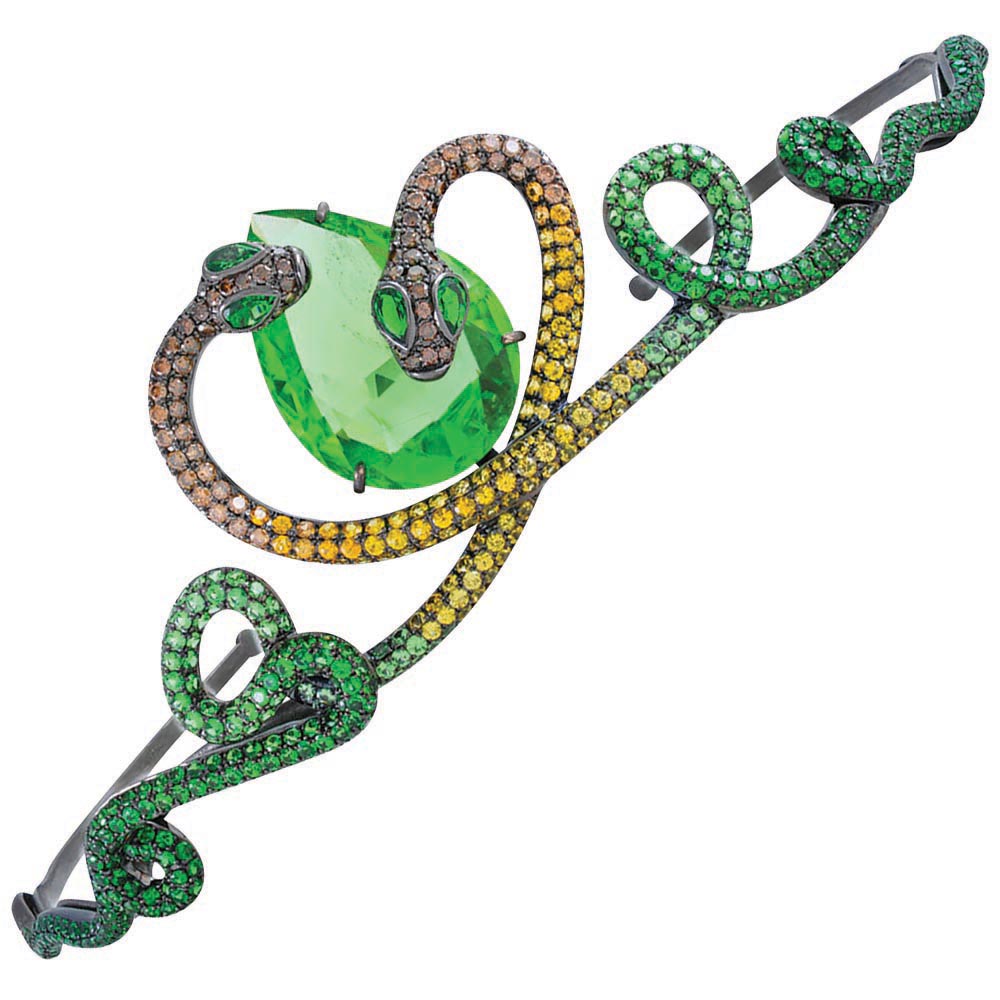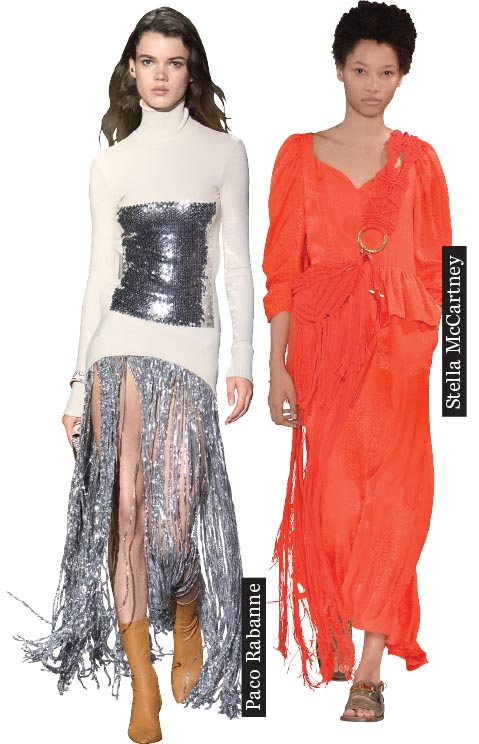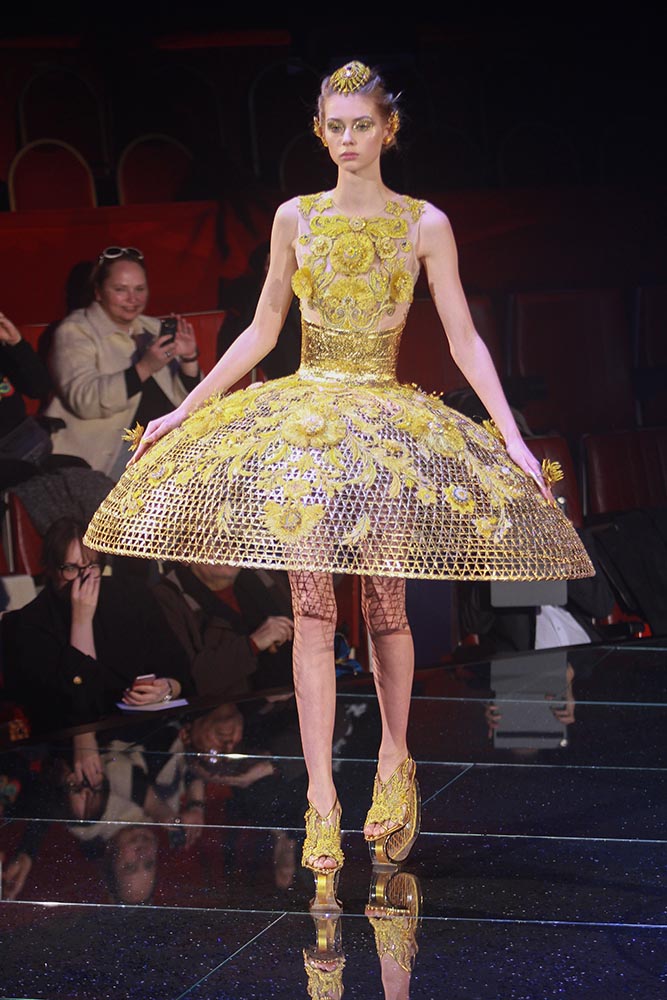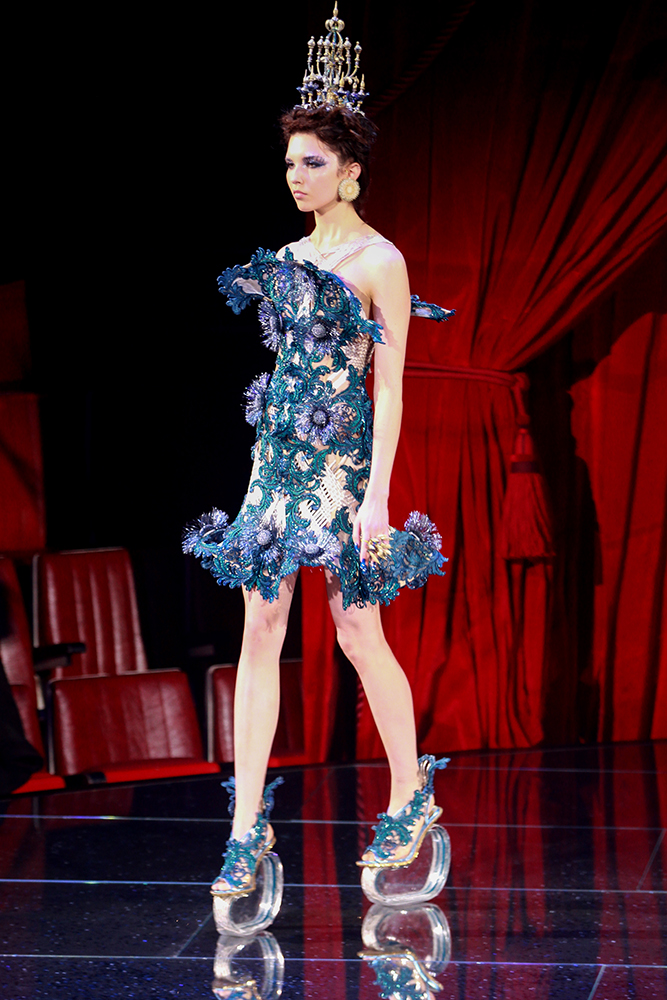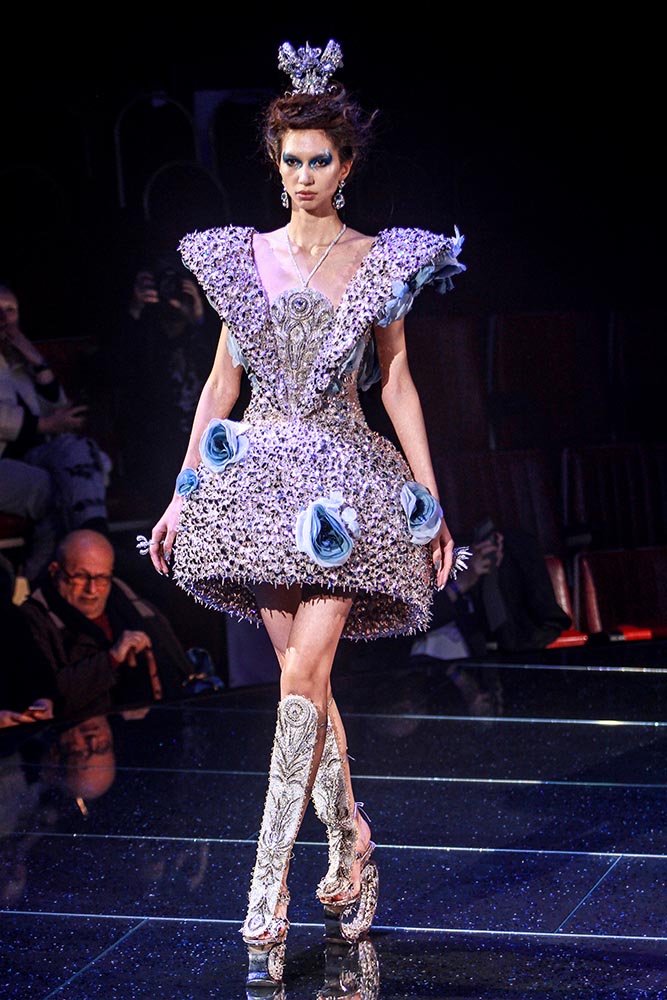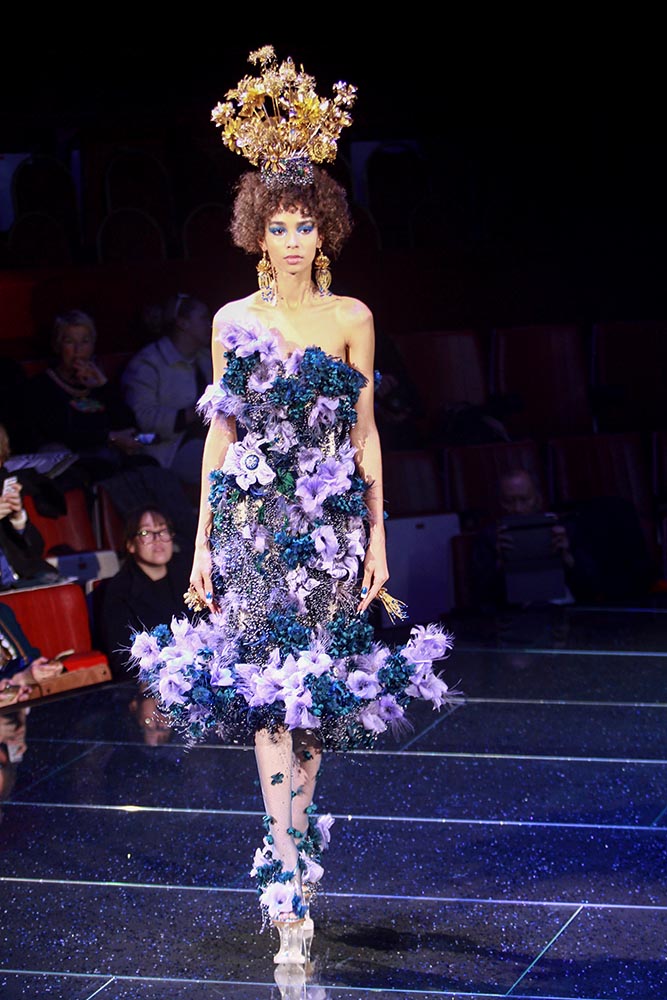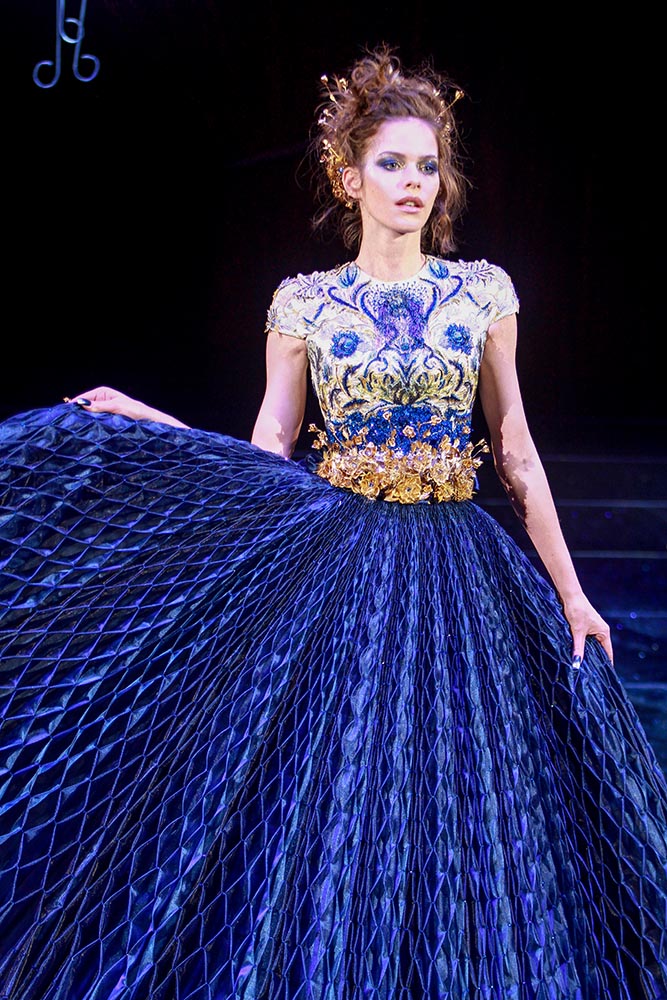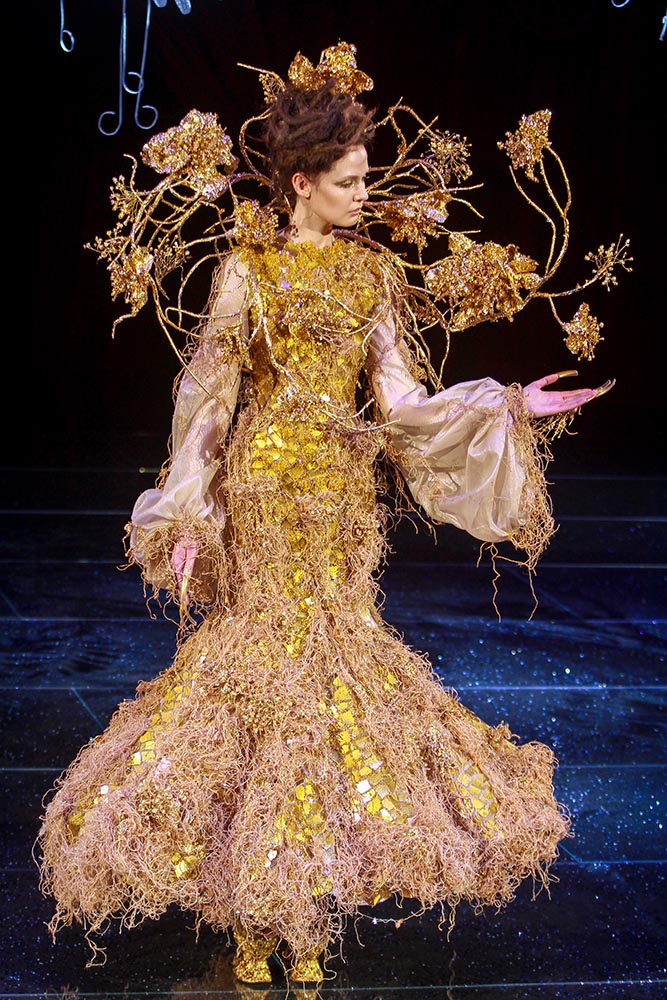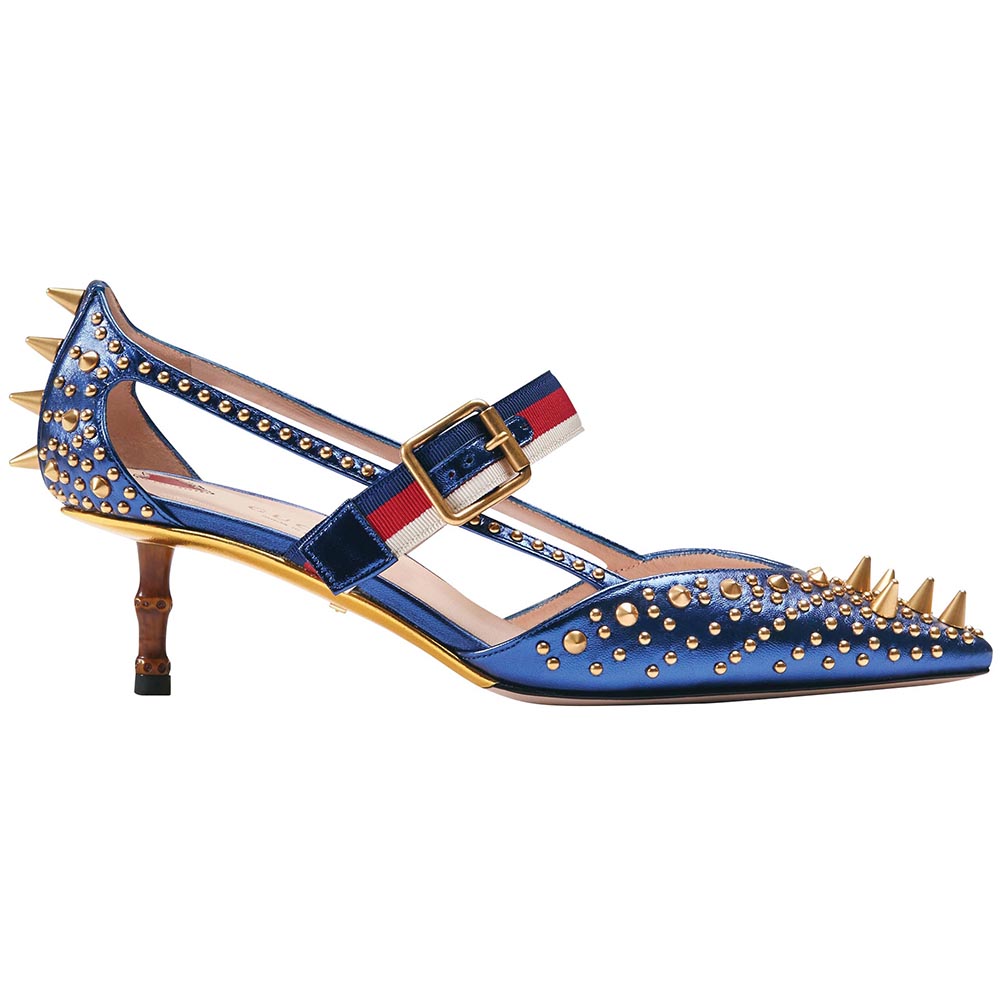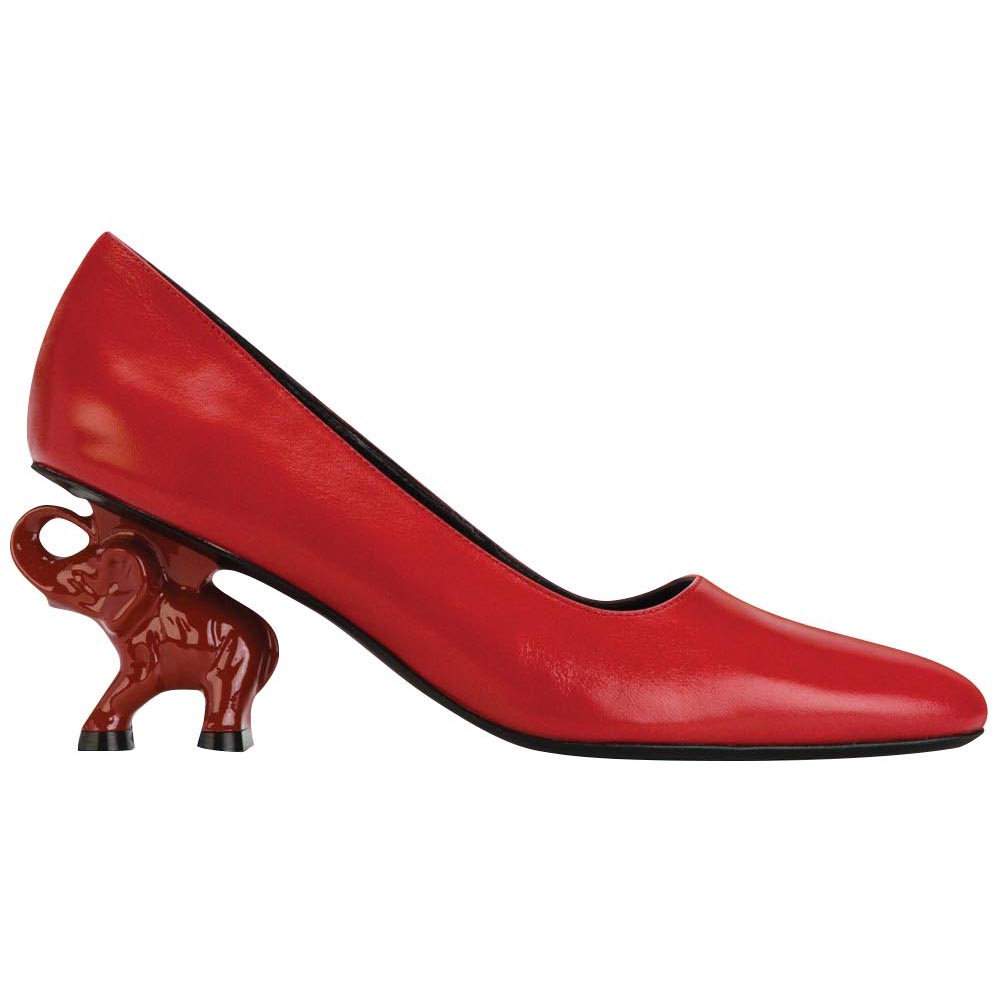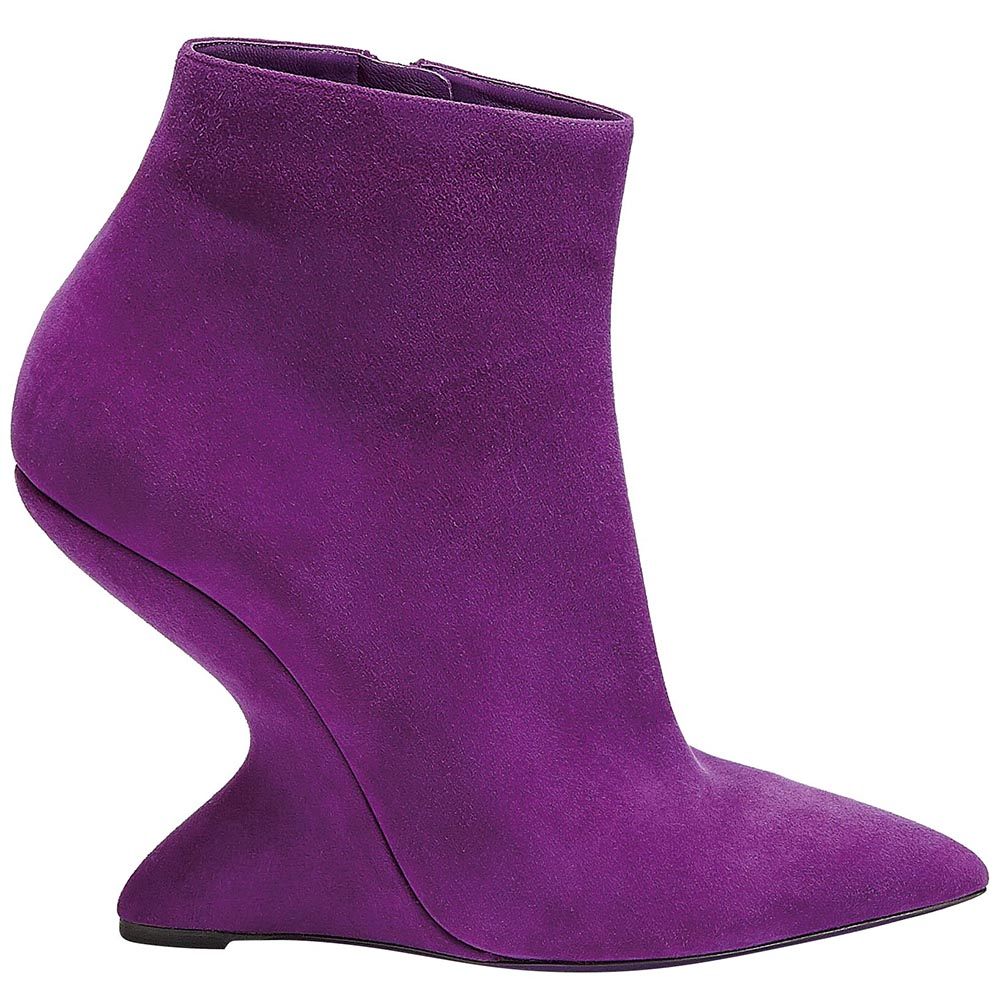









Fashion

Around the World
French jeweller Lydia Courteille’s collections form a unique atlas, inspired by the flora, fauna and the history of her travels
Around the World
French jeweller Lydia Courteille’s collections form a unique atlas, inspired by the flora, fauna and the history of her travels
Lifestyle > Fashion |
Around the World
April 6, 2018 / by Philippe Dova
When Lydia Courteille created her brand in 1987, she initially focused on antique jewellery. After collecting and selling some 7,000 vintage pieces, she turned her hand to jewellery design. For more than 30 years, her haute joaillerie collections – each piece unique and quietly provocative – have been displayed with theatrical flair in her shop on the Rue Saint-Honoré in Paris. She counts global celebrities among her fans, including Madonna, Karl Lagerfeld and Nicole Kidman.
Designer Lydia Courteille
So how often do you introduce a new collection?
I create a collection with a new theme every six months. Each one comprises around 30 unique pieces.
Your Rosa del Inca collection, presented last January at the haute joaillerie event of Paris Fashion Week, was your 57th. Where do you get your boundless inspiration?
Travel inspires me enormously. This collection is a tribute to rhodochrosite, the national stone of Argentina, which I discovered during a trip there; the Argentines call it Rosa del Inca. I was inspired by the different civilisations that have left their mark on the country’s history – the Mapuche, the Inca and, much later, the Spanish. The history, the folklore, the colours, the fabrics, the animals and the plants that I discover during my travels are inexhaustible sources of inspiration.
My previous collection, Un Automne à Pékin, was inspired by my visit to the Forbidden City when I was in the Chinese capital for an exhibition at Lane Crawford. There are lots of feng shui references, with grasshoppers, frogs, dragons and fish – animals that symbolise luck, wealth, prosperity and longevity.
The colours of your designs are very soft and harmonious.
That’s the intention of every collection, the source of its beauty. All the objects reinforce one another. There has to be a consistency in the colours and the shapes. It mustn’t be monotonous. It’s about creating a harmonious whole and that isn’t necessarily easy to achieve. When I start to design a piece, I first have to find the stones, then decide the subject, then the colours that I’ll be adding to create the finished work. Lastly, it has to tell a story and spark desire.
How would you define yourself? Are you an artist? A jeweller?
I’m a dream merchant! [laughs] I sell dreams, stories and beauty – at least I hope I do! I think a woman should be beautiful when she wears the jewellery. When she holds the object in her hand, she has to feel a love for it. It has to be well made, rare and precious – and above all, there has to be a story behind every piece.![]()

Fringe Binge
It shimmers, it sways, it’s a little bit festive – and it’s everywhere this year! Thankfully, fringe is actually practical to wear as well. See our picks, based on different budgets, to help you with some smarter shopping
Fringe Binge
It shimmers, it sways, it’s a little bit festive – and it’s everywhere this year! Thankfully, fringe is actually practical to wear as well. See our picks, based on different budgets, to help you with some smarter shopping

Tracking the Trends
Expect glitter and lots of sparks this year. From the luxury powerhouses to the boutique labels, the spring/summer 2018 collections indicate that we’re in for a year of innovative fashion. Here are some of the most prominent elements that are worth a look in your wardrobe this season
Tracking the Trends
Expect glitter and lots of sparks this year. From the luxury powerhouses to the boutique labels, the spring/summer 2018 collections indicate that we’re in for a year of innovative fashion. Here are some of the most prominent elements that are worth a look in your wardrobe this season
Lifestyle > Fashion |
Tracking the Trends
March 2, 2018 / by China Daily Lifestyle Premium
Bling Thing
Start with a glittery dress, or take the look head-to-toe – just remember, there’s a fine line between ostentatious and glamorous. The style can be enhanced with a matching sparkling ensemble (as at Mary Katrantzou) or more subtle when paired with a monochrome top (Molly Goddard).
Read More
Artistic Touch
This season, stay inspired by the canvas. Luxury powerhouses such as Prada and Versace are spicing up pieces with their odes to the arts – be it graffiti, pop art, collage or even watercolours, as seen at Céline.
Utilitarian Chic
Shorts are essential for warmer weather, but you’d better make sure they’re practical – with belts and multiple pockets. With a focus on neutrals and comfortable materials, they’re probably not going to be the standouts of your ensemble, but they’ll probably match every outfit.
Fringe Fever
It’s time to get a little frivolous. This season, long fringe has been spotted flowing all over – on shoulders, waists and legs. When accompanied by feathers and coloured threads, it harks back to the 1920s flapper era and makes a great party look today.
Country Garden
For a perfect spring outfit, florals are always in. Abandon all those over-the-top flower patterns, though; instead, opt for subtle micro-prints and pastel shades. In essence, go as natural as possible.
Glamour Punk
Plaid, leather and fishnets get a feminine makeover, from Wolk Morais’ fitted tailoring to Balmain’s mermaid tail. Punk stylings return to the catwalk with a refined, graceful take on unconventionality.
![]()
Images: Fendi; Versace; Céline; Kamil Kustosz/Molly Goddard; Chloé; Balmain; TOM FORD; Mary Katrantzou; Stella McCartney; ©Paco Rabanne; Prada; Instagram @wolkmorais (Wolk Morais); Getty Images (Tadashi Shoji); Sandro
Back to top

Plastic Fantastic
The très chic fashion comeback in 2018 – are you a material girl?
Plastic Fantastic
The très chic fashion comeback in 2018 – are you a material girl?
Lifestyle > Fashion |
Plastic Fantastic
March 2, 2018 / by China Daily Lifestyle Premium
Image above: Three models wearing waterproof coats, circa 1965
Look from the resort 2018 collection, Chanel
Andy Warhol once famously said of the denizens of Los Angeles: “They’re beautiful. Everybody’s plastic – but I love plastic. I want to be plastic.” The fashion world definitely agrees with these magical polymers this year – the cool, shiny, futuristic material.
The use of plastic in fashion started around the 1920s, when a range of colours were introduced to Bakelite, an early synthetic plastic that was developed in 1907 for mass production purposes; famed fashion designer Coco Chanel created jewellery in Bakelite. Her rival of the time, Elsa Schiaparelli, also applied this material to buttons. Polyvinyl chloride, or PVC, was plasticised in 1926. The shiny plastic-coated fabric of polyester looks like patent leather, but it’s glossier and even cheaper, making for a great substitute.
The wild 1960s ushered in a new era of embracing boldness, energy and contrasting beauty; this happened alongside the rise of pop art and the youth fashion movement. Mary Quant, the Welsh fashion designer and style icon of the period, rose to fame with her miniskirts, pinafore dresses and shiny, plastic raincoats – her bright colourways and dynamic prints still make for a mischievously chic expression today.
The comeback of plastic in fashion raged back in earnest last year, spotted on a range of designs from street fashion to luxury brands. Calvin Klein’s autumn 2017 ready-to-wear collection introduced a number of plastic-covered jackets for both men and women, as well as dresses; the translucent material reminds one of a plastic sofa cover – what’s underneath
ranges from a plaid wool jacket or a sheer silk dress to a dyed fur coat. Yeezy, Kanye West’s footwear brand, introduced a pair of thigh-high boots in entirely transparent PVC as part of its Season Four collection.
Wonder what haute rainwear looks like? Check out Karl Lagerfeld’s spring 2018 runway show for Chanel – it was held in the Grand Palais in Paris with a waterfall as the backdrop. The luxury brand interpreted waterproof fashion in a very Chanel way, such as styling the classic tweed jacket with a variety of clear PVC accessories, including bucket hats, raincoats, rain capes, gloves, boots and handbags.
This year, are you ready to be one of the plastic people?![]()
Images: Jamie Hodgson/Getty Images (1960s models); CHANEL; Yeezy; Acne Studios; Valextra
Back to top

Cute as a Button
If you think those humble fasteners on your clothes are mundane fashion items, give them a second look. Parisian collector Brigitte Renaud opens the doors of her haberdashery for an exclusive visit
Cute as a Button
If you think those humble fasteners on your clothes are mundane fashion items, give them a second look. Parisian collector Brigitte Renaud opens the doors of her haberdashery for an exclusive visit
Lifestyle > Fashion |
Cute as a Button
March 2, 2018 / by Marine Orlova
You don’t seem to take much notice of these items until they’re missing. But how many shirts and coats sit for months in dark closets because of a lost button? Although they’re indispensable, buttons probably don’t seem like the most exciting part of a garment.
Yet there was a time when they were precious accessories and symbols of social status. Buttons only became affordable with the advent of the Industrial Revolution, when mass production gave birth to the iconic four-hole model. But during the Middle Ages, they were made with gold and remained the privilege of the wealthy; numerous buttons on a jacket meant plenty of money in the pockets. Buttons reached the peak of popularity during the 18th century, when King Louis XIV of France made them most fashionable. He (and, subsequently, all the courtiers) donned jewel-like buttons made with a variety of precious stones, or adorned with highly sophisticated miniature paintings – these buttons often cost more than the whole outfit.
In her vibrant Parisian haberdashery, Brigitte Renaud has amassed a unique collection of buttons from the late 19th and 20th centuries. Carefully arranged by colour, material and style, they look like so many candies. “The buttons say a lot about the origin and the time of clothes,” says Renaud. “They’re precious testimonies of the technical advances and the artistic movements of an era. For example, the buttons from the ’30s were often made with newly invented plastics such as Bakelite, Galalite or Lucite, and were infused with art deco patterns.”
Hovering at the junction of art and design, did you know that artists such as Alberto Giacometti, Fernand Léger, Sonia Delaunay and Pablo Picasso created buttons? Between the two World Wars, renowned Italian fashion designer Elsa Schiaparelli made innovative and arty buttons her trademark. “She worked with Lucien Weingott, a peculiar artist who created buttons in his kitchen with all kinds of natural materials: seeds, nut shells, resins,” explains Renaud.
Read More
Buttons designed for children’s fashion are among the cutest ones in Renaud’s collection. Brightly coloured and made of wood, plastic or ceramic, they often represent small animals or cartoon characters. “Before the ’60s, people spent a lot of time making children’s clothes,” she explains. “Though expensive, the buttons really mattered – they were the icing on the cake.” When asked about the fragility of porcelain or glass buttons, she answers: “They can last for years with good care. Keep in mind that these materials were used before the ’50s and the invention of the washing machine. People washed their clothes by hand – and probably less often than we do now.”
It’s unfortunate that today’s fashion landscape gives less importance to buttons – all the more so as they’re a reliable indicator of a garment’s quality. But the good news is you can change the buttons of your clothes to make them your own and give them a second life. To choose the right ones, remember that they must subtly enhance your look without grabbing all the attention. “One must first notice how stylish your jacket is, not how amazing your buttons are,” says Renaud. Keep the biggest ones for your coats – trimmed ones are very elegant on fur – and pick some tiny glass ones to accessorise your silk shirts. Why not fasten a large cape with a single stylish button, à la Schiaparelli? But definitely use a solid sewing thread – or you may lose your precious treasures!![]()

Classic Contrast
Colour is everything – but black and white is more
Classic Contrast
Colour is everything – but black and white is more

Double Happiness
H&M’s head of design, Ann-Sofie Johansson, on the challenges of making fashion sustainable and sustainability fashionable
Double Happiness
H&M’s head of design, Ann-Sofie Johansson, on the challenges of making fashion sustainable and sustainability fashionable
Lifestyle > Fashion |
Double Happiness
March 2, 2018 / by Olivia James
Some people say sustainable fashion can only comes when we change the business model – when profit doesn’t drive everything.
We want to change the model. We’re a big business, but we want to move into circularity, and the vision is to lead that change towards circular and renewable fashion. Yes, we think that’s kind of a ballsy vision – as it should be. We know people will always love fashion; I love fashion. But we want to know that what we consume is good. Moving into circularity is because we know resources are scarce and we can’t go on using things in the same way we have for the last 30 years. Circularity is both our mantra and our vision, so we can continue to make new fashion out of the old. And we do have some tough goals – by 2030, all the fabrics we create will be from sustainable sources.
How tough is that to achieve?
It’s quite tough, because we don’t have those fabrics yet today. We have organic cotton and we have recycled polyester, but there’s only so much you can do with these fabrics. For a smaller range, we have our Conscious Exclusive collection, which is limited. In that, we try out new sustainable fabrics, which hopefully can be scaled up and applied to more of our collections, but there are challenges.
What are those challenges?
Well, there are new fabrics on the market, like grape leather, for example, but the quantity is just so small. So the crucial part is scaling up for us. But we also invest in a lot of different companies and work with scientists. Here, we work with the Hong Kong Research Institute for Textiles and Apparel (HKRITA). The non-profit H&M Foundation did a collaboration with HKRITA; together we have – or they have – come up with a groundbreaking innovation, which is how to recycle blended fabrics. Recycling up to now has been mechanically made, where materials are ripped apart into separate ones. But with this innovation, we can recycle blended materials without any quality loss. For us, that’s really exciting, and also scalable on a larger and more practical level. This applies to all fashion businesses, not just H&M. That will be interesting to watch. The CEO of HKRITA, Edwin Keh, is someone you should talk to – he’s scientific and also really candid about the challenges.
Read More
Do you think people’s clothing labels will one day proclaim: “Made in such and such a laboratory”?
Maybe! We want to be as transparent as possible – to say this product is grown from this, or to identify a waste product that has been used. Like grape leather, for example – the leftovers from the wine industry. So now we all have to start drinking more wine! There’s something called orange fibre from the citrus peel, which could become something new.
On the topic of scale, you mentioned grape debris. How much of that is needed to make one bag?
It’s very hard to say with grape debris. The only thing I know is that we do Conscious Exclusives once per year. Last year [in April] we had a dress made from bionic yarn, which comes from plastic waste gathered from the shorelines of China. I can tell you that 89 plastic bottles went into that one dress. And it was really beautiful, too. It’s a good concrete example of this whole process.
What challenges are there that you feel consumers don’t understand about the sustainability debate?
For us, it’s still a question of making fashion that people want to wear. We have to be able to merge the two worlds even better – to make sustainability fashionable and fashion sustainable. That’s the challenge and that’s what Conscious Exclusive is about. We can make really beautiful clothes today using sustainable fabrics and make it all fashionable, because making sustainable clothes just for the sake of sustainability, without making them fashionable, makes no sense. That’s also not sustainable.
How much thought is given to how recyclable a collection is at the end of its life cycle?
To be honest, not enough – we’re not there yet. Again, it’s the marriage of sustainability and fashion. Everybody working at H&M, every designer, knows that we get opportunities and they know our values; they know the fabrics they can choose from. But I wish we could do more – and we have to, especially with 2030 in mind. Though now, with recycling and scientific breakthroughs like recycling-blended fabrics, it has become a bit easier.
What happens to fast fashion when sustainability catches up?
You know, we don’t like this term,“fast fashion”. But I met a professor in England who was thinking of extending the idea further in this way – what if we want to buy a top for going out on Saturday night; could we make it disposable? For example, after you wear it, it disappears, breaks down into cells or fibres, and can be recycled in a new way. You enjoy the party top, then it fades. That changes people’s reaction to “fast fashion” – from something intrinsically bad to something very progressive. We all love new things, we want new things, and this is a way to find novelty and turn that into something positive. We want to do good. That’s also why we want to be on top of change and lead.
Dutch designer Iris Van Herpen talks about not even wearing clothes in the conventional sense.
She’s right! And think about this: maybe you can just scan the image of what you want to wear onto yourself. So you would have, say, a body stocking, and you just scan a picture of that perfect print or the hue you want to wear, or something like that. It’s a sort of virtual reality.![]()

Go Luxe or Save Bucks
Stylish sweaters and animal-inspired prints are all the rage; the former keeps your body warm and the latter makes a bold statement. We’ve picked a few key pieces at a variety of price points to help you manage your style and your bank account at the same time
Go Luxe or Save Bucks
Stylish sweaters and animal-inspired prints are all the rage; the former keeps your body warm and the latter makes a bold statement. We’ve picked a few key pieces at a variety of price points to help you manage your style and your bank account at the same time

Pride and Passion
Top-notch Chinese couturier Guo Pei is exhibiting 46 pieces of haute couture craftsmanship in Atlanta through March 4, including the famous “dragon robe” Rihanna wore in 2015
Pride and Passion
Top-notch Chinese couturier Guo Pei is exhibiting 46 pieces of haute couture craftsmanship in Atlanta through March 4, including the famous “dragon robe” Rihanna wore in 2015
Lifestyle > Fashion |
Pride and Passion
January 26, 2018 / by China Daily Lifestyle Premium
image above: Guo Pei
The famed “dragon robe”, 2015
An intricate look from the autumn 2017 couture collection
A creation for Garden of Soul, Guo’s collaboration with cosmetics giant MAC
Born and raised in the 1960s in Beijing, Guo Pei is the most renowned Chinese designer in haute couture. In 2015, when Rihanna wore Guo’s imperial yellow cape gown to the annual Met Gala in New York (the theme that year was “China: Through the Looking Glass”), the designer’s name and fame went truly international – but she didn’t know who Rihanna was when the pop singer approached her for a dress.
The voluminous gown, dubbed the “dragon robe” on Chinese social media, is now on display at the designer’s solo exhibition Guo Pei: Couture Beyond, being held until March 4 at SCAD FASH Museum of Fashion + Film in Atlanta. The dress – featuring a 16-foot train and weighing 25kg – epitomises Guo’s laborious production methods. Also known as “magnificent gold” (or da jin in Putonghua), it was the designer’s first haute couture masterpiece and her most important one. The dress features real gold threads and fine embroidery, and took her team of nearly 500 artisans some 50,000 hours to make.
How did Guo rise to the top of Chinese haute couture? In 1986, she graduated from the Beijing Second Light Industry School as one of the country’s earliest students to major in fashion design – just nine years after the national university entrance exam resumed in 1977. Guo grew up during the Cultural Revolution, an era of hardship when any adornment and individualism was strictly prohibited, and she wore only neutral-coloured and plain garments. But she was determined to become one of China’s first fashion designers.
Read More
After ten years of designing for major Chinese manufacturers, Guo left her stable career path and started Rose Studio in 1997. It was a decision to pursue her artistic freedom – to design and express herself without constraints.
In China, Guo became widely recognised for the gowns and costume dresses she designed for the female hosts of the CCTV Spring Festival Gala; the Lunar New Year’s Eve programme is the most-viewed television event in the country. In 2008, she designed an elegant shoulder-baring dress for Zhang Ziyi to wear at the torch lighting ceremony in Athens, in the lead-up to the Beijing Olympics. The experienced couturier didn’t go with the actress’s original plan for a qipao, but made a piece that conveys traditional Chinese elements through a modern silhouette and intricate cutting.
In 2016, Guo became the first Chinese designer invited to join the Chambre Syndicale de la Haute Couture, the prestigious French regulatory body, which also allowed Guo to make her debut show that year at Paris Haute Couture Fashion Week.
Today, as the designer’s name and fame has outshined her previous Rose Studio label, the haute couturier has finally launched an eponymous brand, together with a new studio in the upscale boutique shopping district on the Rue Saint Honoré in Paris, targeting an international clientele.
Blending elements of traditional Chinese culture with a modern presentation, and aesthetics that communicate with both East and West, Guo’s haute couture craftsmanship stands proudly, showcasing her lifelong passion for fashion and her decades of expertise in dressmaking. ![]()
Sketch for Story of the Dragon, 2012
Spring 2018 Couture
Images: Guo Pei/Guo Pei Rose Studio (portrait); Guo Pei (Garden of Soul, AW17 couture); Savannah College of Art and Design/SCAD (sketch and shoes); Photos by BOBO (Spring 2018 Couture)
Back to top

A Step Up
Once essential accessories for male soldiers, high heels have transformed to represent wealth, nobility and a manifestation of provocative beauty
A Step Up
Once essential accessories for male soldiers, high heels have transformed to represent wealth, nobility and a manifestation of provocative beauty
Lifestyle > Fashion |
A Step Up
January 26, 2018 / by China Daily Lifestyle Premium
Louis XIV of France, painted by Hyacinthe Rigaud, 1701
Manolo Blahnik once said, “You put high heels on – and you change.” In modern times, glamorous sky-high heels may be of little practicality, but dating back to the 10th century, they were essential accessories for men in battle in the Near East.
Shoes with heels are widely considered to have originated from the Persian Empire. Cavalry in the region wore heeled boots to stay mounted on their horses; with the heels providing a crucial security measure, the arrow-shooting riders could stand in the stirrups while the horses galloped. Later, these practical riding boots transformed into cowboy boots in the US.
In Europe during the Middle Ages, pattens were heeled overshoes that both men and women would slip on before heading out. The heels, which were usually wooden-soled, could elevate the foot above the grime at street level – as sewage systems and water pipes weren’t a feature of medieval towns, it was common to throw garbage and human waste into the streets. In the 15th century, leather pattens became fashionable and in London, a wealth of new styles emerged including multi-layered leather soles, ones with narrow, elongated toes, and shoes that could be worn over hosiery.
Similar to pattens, chopines were also platform shoes, but worn exclusively by women. Believed to have been created in 15th-century Turkey, chopines were adopted by the Venetians from the 15th to 18th century, and were popularly worn by courtesans and patricians.
These ultra-high heels – which could rise up to some 75cm above the ground – were deemed a representation of prestige and the fragility of woman. But the inconvenience of chopines sparked rumours that they had been invented by men who wanted to prevent their wives from engaging in illicit affairs by making it difficult to walk. Chopines were lavishly embellished, with beautiful decorations such as embroidery, gold lace and leatherwork, forever linking high heels with the feminine aesthetic.
In the most iconic portrait of Louis XIV, created by French painter Hyacinthe Rigaud in 1701, the king of France sported red heels over tights. For the portrait, the famously short man – at 162cm, he often wore wigs to exaggerate his height – purposely posed with one leg stretched out to make his frame look elongated.
As photography emerged in the 19th century, high heels made a perfect beauty enhancement in pictures. This reached a fever pitch in the 1940s, when the famed pin-up girls posed in high heels in most of their photographs, drawings and posters. Though these pin-ups were popular during wartime in the men’s barracks, it was after the Second World War ended when stilettos were invented; among those credited with popularising the innovation are Salvatore Ferragamo, Roger Vivier and André Perugia. The thin, long and often ultra-high heels also became an item commonly worshiped in fetish subcultures.
Today, high heels are a glamorous staple of every woman’s wardrobe and, as designers continue to innovate, the future of heels is seemingly unlimited. ![]()
Reconstruction of a Venetian-era chopine, on display at the Shoe Museum in Switzerland
Pulp cover for Flirt magazine, April 1953, by American pin-up artist Peter Driben







